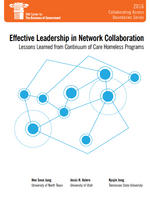
Effective Leadership in Network Collaboration: Lessons Learned from Continuum of Care Homeless Programs

The authors collected data from a survey of 237 homeless program networks across the nation, as well as in-depth reviews and interviews of four CoC homeless networks in three states. While this report focuses on homeless networks, its findings and recommendations are applicable to networks in all service delivery areas.
The trend toward using “collaborative” networks has been increasing in recent years; because of their increased use, new leadership approaches will be needed by executives who are “managing” networks in non-hierarchical situations. In contrast to the traditional hierarchical style of management in single agency bureaucracies, network leaders need to work across organizations and sectors.
After presenting findings from the authors’ survey and case examinations, the authors present six recommendations for leaders facing the challenge of managing networks. It is clear that a new management style is required for networks. The authors’ recommendations include: develop expertise, cultivate a collaborative culture, take risks, use inclusive leadership, use agile and adaptive management practices, and ensure effective use of performance indicators.
The report builds on the Center’s previous reports on collaboration and adds another example—homeless networks—where collaboration is being used to work across organizations and sectors. Previous IBM Center reports on collaborating across boundaries include Inter-Organizational Networks: A Review of the Literature to Information Practice by Janice Popp, H Brinton Milward, Gail MacKean, Ann Casebeer, and Ron Lindstrom; Collaboration Between Government and Outreach Organizations: A Case Study of the Department of Veterans Affairs by Lael Keiser and Susan Miller; and Implementing Cross-Agency Collaboration: A Guide for Federal Managers by Jane Fountain.



